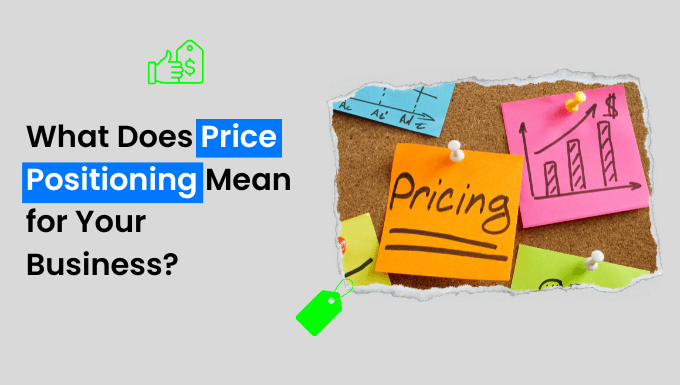Are you struggling to make your product stand out in a crowded market?
Price positioning is the secret weapon that can skyrocket your business success.
By strategically setting your prices, you’ll not only attract potential customers but also differentiate your product from competitors.
Discover how to craft a winning business pricing strategy that maximizes profits and builds brand loyalty.
Ready to unlock the power of strategic pricing and transform your market position?
Key Takeaways:
- Price positioning shapes customer perception and influences buying decisions.
- Effective pricing strategies balance profitability with market competitiveness.
- Understanding your target audience is crucial for successful price positioning.
- Analyze competitors to identify opportunities for differentiation.
- Regularly review and adjust your pricing strategy to maintain market relevance.

Contents
TogglePricing is not just about slapping a number on your product, it’s about creating value perception, building trust, and maximizing profitability.
Factors Influencing Price Positioning
Today, we will explore the complex world of pricing strategies and the key factors that significantly impact how you position your prices in the market.
Let’s break down the factors step by step:
1. Market Demand:
Market demand is the lifeblood of your business. Effective product positioning can significantly enhance this demand by aligning what you offer with the needs and wants of potential customers.
Effective product positioning can significantly enhance this demand by aligning what you offer with the needs and wants of potential customers.
It’s like the pulse that indicates what your customers need and how much they are willing to pay for it.
For Example: Think of the fast-food industry, where market demand fuels constant innovation and fierce competition among players.
Similarly, ride-sharing companies adjust their prices based on market demand to stay competitive and meet customer expectations.
Their market research reveals that pricing flexibility and positioning emphasize meeting needs promptly.
2. Level of Competition:
Competition in the market can be likened to that persistent sibling always vying for the spotlight. Positioning your product effectively can help you stand out and gain the competitive edge you need.
Positioning your product effectively can help you stand out and gain the competitive edge you need. The intensity of competition can make or break your pricing strategy.
Fast-food chains, for instance, engage in a constant battle of wits through innovative offerings and competitive pricing to maintain their market position.
In the retail landscape, where businesses are plentiful, standing out with unique products and pricing strategies is crucial for their survival. Effective product positioning helps differentiate your product from competitors, making it a key factor in retail success.
3. Product or Service Differentiation:
What makes your offering stand out in a sea of competitors?
Product or service differentiation is all about highlighting the unique value proposition that sets your business apart, a core concept of how positioning refers to making your offer distinctive.
Take Apple, for example. Their premium pricing for products like iPhones and MacBooks is justified by superior design and user experience.
Similarly, FreshPet food distinguishes itself with a focus on natural ingredients, catering to pet owners seeking high-quality nutrition for their furry companions.
4. Target Market Segment:
Understanding your target market segment is essential for tailoring your products, packaging, and marketing efforts effectively.
A local pizza joint may cater to budget-conscious consumers, while a fine dining restaurant caters to a more upscale clientele.
By pinpointing your target audience, you can align your offerings with their preferences and needs, enhancing customer satisfaction and loyalty.
5. Production Costs and Profit Margins:
Behind the scenes, market research and analyzing production costs and profit margins play a pivotal role in shaping your pricing strategy, a critical aspect of positioning a product in the market.
Monitoring your cost of goods sold (COGS), which includes raw materials and labor expenses, allows you to optimize your profit margins.
Understanding these costs is crucial for effective product positioning, as it helps ensure that your product’s price reflects its value accurately.
Additionally, analyzing your operating margins provides valuable insights into your financial performance, enabling informed pricing decisions that balance profitability and competitiveness.
Exploring Different Price Positioning Strategies
Now delve into the dynamic world of pricing strategies.

Get ready for an exciting journey as we explore various approaches to pricing your products or services to boost profits and attract your ideal customers.
1. Cost-Plus Pricing: The Classic Formula
Imagine you’re managing an e-commerce store specializing in candles.
With cost-plus pricing, you start by calculating the total cost of producing each candle, considering materials and labor (let’s say it amounts to $10).
Then, you add your desired profit margin (let’s go with a 50% markup). Voilà! Your selling price is determined at $15.
This straightforward strategy ensures profitability and is a go-to choice for many businesses.
2. Value-Based Pricing: It’s All About Perceived Value
Ever wondered how Apple can command premium prices for their iPhones and MacBooks?
This is a prime example of how brand positioning creates value in the consumer’s mind, distinguishing your offering from similar products. It’s all about value-based pricing.
By aligning prices with the perceived value to the customer, Apple emphasizes superior design and user experience, justifying those higher price points.
This strategy not only caters to customer preferences but also fosters brand loyalty, setting you apart from competitors.
3. Premium Pricing: Luxury Vibes Only
If you’re targeting the high-end market, premium pricing could be your golden ticket, emphasizing the importance of how the price of a product reflects its market positioning.
Think of luxury car brands like Mercedes-Benz or iconic timepieces like Rolex watches.
By setting prices above the average market value, you create an aura of exclusivity and quality.
This pricing strategy works well when your product positioning focuses on luxury and premium market segments. This pricing strategy works well when your product positioning focuses on luxury and premium market segments.
This approach appeals to discerning customers, boosts your brand reputation, and ensures healthy profit margins, demonstrating how positioning makes a significant difference in market perception.
4. Economy Pricing: Budget-Friendly Deals
For those aiming to compete on affordability, economy pricing is the way to go.
By trimming production and marketing costs, you can offer budget-friendly options to price-conscious customers.
Take, for instance, generic store brands like Costco’s Kirkland Signature products.
By keeping costs low, they attract savvy shoppers and focus on customer acquisition without compromising quality.
5. Psychological Pricing: Playing Mind Games (In a Good Way)
Ever noticed prices like $9.99 instead of $10? That’s the magic of psychological pricing in action.
By leveraging human psychology, this strategy creates the perception of affordability, grabs the customer’s attention, and nudges them towards making a purchase.
It’s a subtle yet effective way to influence consumer behavior and drive sales. Positioning statement clarity ensures that marketing efforts resonate with potential customers, subtly steering them towards your product.
Positioning statement clarity ensures that marketing efforts resonate with potential customers, subtly steering them towards your product.
6. Dynamic Pricing: Ride the Wave of Demand
In a fast-paced market environment, dynamic pricing shines. By adjusting prices in real-time based on factors like demand, seasonality, or inventory levels, you can maximize revenue and stay competitive.
This dynamic pricing strategy benefits from strong market research and product positioning to better meet the needs of potential customers.
Think of airlines tweaking ticket prices based on demand or ride-sharing apps surging prices during peak hours.
This strategy keeps you agile and responsive to market fluctuations. Regular market research supports nimble product positioning, allowing for swift adaptability in a changing market.
Regular market research supports nimble product positioning, allowing for swift adaptability in a changing market.
7. Price Skimming: The Early Bird Gets the Worm
Launching a new product? Price skimming might be your strategy of choice.
Begin with a high initial price to target early adopters willing to pay a premium for novelty. As time progresses, gradually reduce the price to attract a broader customer base.
This approach not only capitalizes on initial excitement but also helps recover development costs swiftly, paving the way for long-term success.
8. Penetration Pricing: Making a Splash in the Market
Looking to gain market share swiftly? Penetration pricing is your ally.
By setting a low initial price to attract price-sensitive customers and encourage trial, you can make a splash in the market.
Imagine new food delivery services offering discounted rates to entice users and disrupt the competition.
This strategy facilitates rapid market entry, customer base expansion, and a competitive edge, proving an effective positioning strategy is invaluable.
Benefits of Effective Price Positioning in Your Business
In the dynamic world of business, setting the right price for your products or services can be a game-changer.
Effective price positioning goes beyond randomly selecting a price range, it involves a strategic decision that can significantly impact your bottom line, customer loyalty, and overall brand perception.
The key advantages of mastering price positioning in your business include building brand loyalty and setting your product aside from similar products.
Enhanced Profit Margins: Maximizing Profits Strategically
When you nail your price positioning, you’re not simply guessing numbers. You’re strategically determining prices that allow you to maximize profits without devaluing your offerings.
Every rupee added to your price directly affects your profit margins. Strategic pricing and product positioning emphasize creating value that customers are willing to pay for.
Proper price positioning ensures you’re not missing out on potential revenue while still providing price and quality value to your customers.
Market Segmentation: Tailoring Prices for Different Segments
A one-size-fits-all pricing approach doesn’t work, highlighting the importance of optimal price and product positioning strategies in marketing.
Effective price positioning empowers you to customize prices for various customer segments.
By understanding the distinct needs and willingness to pay of different customer groups, you can create pricing strategies that resonate with each segment.
This targeted approach not only boosts sales but also enhances customer satisfaction and loyalty.
Brand Perception: Shaping Customer Views on Value
Your pricing strategy is a potent tool that shapes how customers perceive your brand. It is essential for building brand identity and positioning to emphasize the value your product brings.
The way you position your prices conveys a message about the value you offer.
Are you a luxury brand commanding premium prices for exclusivity, or are you a budget-friendly option focused on accessibility?
This question is crucial in understanding the types of product positioning your brand opts for.
Your price positioning plays a crucial role in defining your brand identity and influencing consumer perceptions, showcasing how positioning helps businesses stand out.
Competitive Advantage: Differentiating in a Crowded Market
In a competitive marketplace, pricing can be a game-changer, especially when combined with effective product positioning strategies.
Effective price positioning allows you to use pricing as a competitive advantage, highlighting how positioning can make or break the success of a product or brand.
Whether you opt to undercut competitors, differentiate based on value, or create a premium image, your pricing strategy can set you apart from the competition.
By strategically positioning your prices, you can carve out a unique space in the market and attract customers aligned with your brand.
Customer Loyalty: Fostering Trust Through Consistency
Consistency is vital in pricing. Ensuring that your pricing strategy is coherent with your brand and product positioning can build customer trust and loyalty.
By maintaining consistent pricing, you build trust with your customers.
When customers know what to expect and feel they receive fair value for their money, they are more likely to return.
Price fluctuations can erode trust and lead to customer dissatisfaction, underscoring the challenge of maintaining positioning examples that reassure customers about price and quality.
Effective price positioning involves not only setting the right prices initially but also sticking to those prices over time.
Mastering Pricing Strategies: Lessons from Apple, Walmart, Tesla, and Starbucks
In the fiercely competitive business landscape, pricing strategies play a crucial role in influencing consumer behavior and maintaining the growth of profit margin.
Now let’s discuss the pricing tactics of industry giants like Apple, Walmart, Tesla, and Starbucks to uncover the secrets behind their remarkable success.
Apple: The Art of Premium Pricing
When we think of Apple, we conjure images of sleek designs and cutting-edge technology, a clear testament to how effective product positioning is a strategic element in their success.
Their successful product positioning focuses on innovation and premium quality, creating a strong brand awareness among consumers.
A cornerstone of Apple’s pricing strategy is premium pricing, prominently seen in products like the iPhone and MacBook Pro.
By setting higher price points compared to competitors, Apple positions itself as a luxury brand, emphasizing superior quality and consumer experience.
Key Points:
- Apple’s premium pricing strategy is justified by the cost of production, with the iPhone 13 Pro costing around $600 to manufacture, a clear example of positioning for a high price to reflect perceived value.
- The brand’s exceptional reputation and desirability compel consumers to willingly pay a premium for Apple products.
- In addition to premium pricing, Apple employs freemium pricing strategies for services like Apple TV, Apple Music, and Apple Arcade, enticing users with free options and encouraging upgrades for enhanced features.
Walmart: The Power of Everyday Low Price (EDLP)
Walmart, the retail behemoth, thrives on its Everyday Low Price (EDLP) strategy, offering consistently low prices without relying heavily on frequent sales or discounts.
This approach simplifies decision-making for consumers, reduces search costs, and ensures value for money.
Despite operating on thin profit margins, Walmart’s high sales volume compensates for the low prices, making it a preferred destination for budget-conscious shoppers.
Key Points:
- Walmart’s pricing strategy, which is based on a standardized menu, helps to simplify operations by providing the same menu in all stores. This also supports the procurement of raw materials in bulk and reduces costs, showcasing a marketing approach that positions the company as efficient and cost-effective.
- The retailer’s diverse product range caters to various consumer preferences, providing a comprehensive shopping experience for customers.
This variety in offering similar products enables the retailer to meet the needs of a broader consumer base.
Tesla: Dynamic Pricing for Innovation
Tesla, the pioneer in electric vehicles, adopts dynamic pricing strategies to maintain a competitive edge in the market.
By adjusting prices based on demand and supply fluctuations, Tesla remains flexible and responsive to changing market conditions.
Departing from traditional auto industry norms, Tesla’s premium pricing model is justified by its brand identity, quality, and unique product features, showcasing how an effective product positioning statement influences perceptions.
Key Points:
- Tesla’s dynamic pricing strategy allows frequent price adjustments to stimulate demand or adapt to supply chain challenges.
- Despite its premium pricing, Tesla continues to be profitable, showcasing the effectiveness of its innovative pricing approach and how product positioning is a strategic priority.
Starbucks: Blending Value-Based Pricing and Strategic Branding
Starbucks, the coffeehouse giant, melds value-based pricing with strategic branding to deliver a captivating consumer experience.
By analyzing consumer behavior and maintaining consistency in services and menu offerings, Starbucks ensures profitability while appealing to a broad customer base.
Strategic store placements based on demographics, along with promotional activities during events and holidays, further enhance Starbucks’ brand visibility and customer engagement, showcasing a multifaceted product positioning strategy.
Key Points:
- Starbucks’ value-based pricing strategy aligns prices with consumer preferences, offering a diverse menu to cater to varying tastes.
- The coffee chain’s focus on branding and promotions bolsters sales and attracts a wide consumer base, illustrating how positioning works in the practical world despite its premium pricing.
These industry leaders exemplify how strategic pricing can shape brand positioning, drive profitability, and foster customer loyalty.
Take inspiration from the playbooks of Apple, Walmart, Tesla, and Starbucks to craft a pricing strategy that sets your business apart.
Developing a Business Pricing Strategy
Now, we will show you the exact steps to develop a business pricing strategy for your business:
1. Evaluate Market Standing and Set Goals
Embarking on the journey of crafting a business pricing strategy requires a strategic approach, focusing on how positioning a product can influence its success.
Begin by assessing your position in the market landscape through thorough market research and analyzing how your product and brand stand against competitors.
Determine whether you are a prominent player in a niche market or a newcomer in a competitive industry.
Define your business objectives with clarity and precision to set a strong foundation for your pricing strategy.
2. Analyze Your Target Audience
Delve into the minds of your target audience, unraveling their desires, fears, and purchasing behaviors.
Understanding what motivates your customers to make purchasing decisions is akin to solving a captivating mystery, where positioning means uncovering the values that matter most to your target audience.
By empathizing with your audience, you can tailor your pricing strategy to meet their needs effectively.
3. Study Your Competitors
View your competitors as worthy adversaries in the realm of business. Analyze their pricing tactics, market positioning, and strategies to gain valuable insights.
Learn from their successes and failures, leveraging this knowledge to refine your pricing approach.
Embrace a mindset of continuous improvement by staying informed about your competitors’ movements.
4. Create and Execute Your Pricing Strategy
Now it’s time to design your pricing strategy, considering product positioning strategies to establish a strong market presence.
Consider factors such as production costs, value proposition, and industry trends when formulating your approach to ensure your company may achieve optimal brand positioning.
Implement your strategy decisively, aligning it with your business goals to achieve optimal results.
Adapt these strategic steps to suit your unique business environment and venture forth confidently into the realm of profitable pricing strategies.
People Also Asked
1. Why is Price an Important part of Positioning Strategy?
Price plays a crucial role in shaping how consumers perceive your brand. Here’s why it’s a vital component of your positioning strategy:
- Perceived Value: The price you set can significantly influence how customers perceive the value of your product or service, showing how closely linked product positioning shapes consumer perceptions. A higher price tag often signals quality and exclusivity, while a lower price may suggest affordability but potentially lower quality.
- Competitive Advantage: Setting the right price can give you a competitive edge in the market. Coupled with strategic product positioning, this ensures your product appeals directly to the needs and desires of your target customers, solidifying your market standing. It effectively builds brand loyalty by offering similar products with discernible improvements. By offering a unique value proposition at a certain price point, you can differentiate yourself from competitors and attract your target audience.
- Profit Margin: Price directly impacts your profitability, a basic principle that underlines the relevance of an effective positioning strategy in financial success. Finding the right balance between competitive pricing and maintaining a healthy profit margin is essential for the long-term success of your business, a strategy that hinges on effective product positioning and an optimal pricing approach.
2. How does price positioning affect business?
How you position your prices can significantly affect your business outcomes:
- Customer Perception: Your pricing strategy plays a crucial role in shaping how customers perceive your brand. Whether positioning yourself as a luxury brand with premium pricing or a budget-friendly option, it influences how consumers view your products or services, demonstrating how positioning defines brand perception.
- Market Positioning: Price positioning determines where your brand stands in the market and how positioning is the process that identifies the optimal market niche. Are you targeting the high-end luxury segment or catering to the mass market? This decision will determine how you position your brand effectively to meet consumer expectations.
- Revenue Generation: The right price positioning can drive revenue growth. Aligning your pricing strategy with your product’s positioning helps attract the right customers and maximizes your revenue potential. This makes your product more appealing compared to similar products in the market.
3. What is a low-price positioning strategy?
A low-price positioning strategy involves offering products or services at a lower price point than competitors.
While this can attract price-sensitive customers, it’s essential to consider the following: effective positioning helps ensure that even if you compete on price, your product stands out for its value to potential customers.
- Volume of Sales: Lower prices can lead to higher sales volume, but it’s crucial to ensure that the increased sales offset the lower profit margins.
- Brand Perception: Offering low prices may impact how customers perceive your brand. It’s important to maintain quality and value perception even with lower pricing.
- Competitive Advantage: Competing solely on price may not be sustainable in the long run, highlighting the necessity of a robust product positioning statement. Consider other value propositions, such as exceptional customer service or unique product features, to differentiate your brand.
4. What is the best pricing strategy for a small business?
For small businesses, selecting the right pricing strategy is crucial for success. Here are some strategies to consider:
- Cost-Plus Pricing: Calculate your costs and add a markup to determine the selling price, a basic marketing strategy that lacks a nuanced positioning template but focuses on covering costs and achieving a profit. A well-crafted positioning statement can guide these financial strategies by defining how your product meets the needs of your market uniquely.
- Value-Based Pricing: Set prices based on the perceived value to customers. This strategy aligns with product positioning by ensuring your pricing reflects the unique value and benefits your product offers to potential customers, underlining that positioning is a strategic exercise fundamental to setting prices.
- Penetration Pricing: Introduce products at a lower price to gain market share quickly. As your customer base grows, you can gradually increase prices, a tactic that aligns with the marketing strategy of product positioning for higher value perception.
- Bundle Pricing: Offer products or services in bundles at a discounted price. This strategy can encourage customers to purchase more and increase overall sales.







